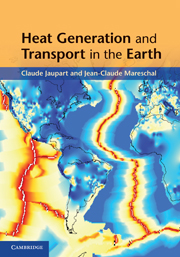Book contents
- Frontmatter
- Contents
- Introduction
- Credits
- 1 Historical notes
- 2 Internal structure of the Earth
- 3 Basic equations
- 4 Heat conduction
- 5 Heat transport by convection
- 6 Thermal structure of the oceanic lithosphere
- 7 Thermal structure of the continental lithosphere
- 8 Global energy budget. Crust, mantle and core
- 9 Mantle convection
- 10 Thermal evolution of the Earth
- 11 Magmatic and volcanic systems
- 12 Environmental problems
- 13 New and old challenges
- Appendix A A primer on Fourier and Laplace transforms
- Appendix B Green's functions
- Appendix C About measurements
- Appendix D Physical properties
- Appendix E Heat production
- List of symbols
- References
- Index
- Plate section
7 - Thermal structure of the continental lithosphere
Published online by Cambridge University Press: 18 December 2014
- Frontmatter
- Contents
- Introduction
- Credits
- 1 Historical notes
- 2 Internal structure of the Earth
- 3 Basic equations
- 4 Heat conduction
- 5 Heat transport by convection
- 6 Thermal structure of the oceanic lithosphere
- 7 Thermal structure of the continental lithosphere
- 8 Global energy budget. Crust, mantle and core
- 9 Mantle convection
- 10 Thermal evolution of the Earth
- 11 Magmatic and volcanic systems
- 12 Environmental problems
- 13 New and old challenges
- Appendix A A primer on Fourier and Laplace transforms
- Appendix B Green's functions
- Appendix C About measurements
- Appendix D Physical properties
- Appendix E Heat production
- List of symbols
- References
- Index
- Plate section
Summary
Objectives of this chapter
In this chapter, we shall pursue several objectives. The first one is to discuss how to determine the distribution of heat-producing elements (HPEs: K, Th, U) in the continental crust and the steady-state temperatures in the lithosphere. A second objective is to discuss whether and how varying thermal regimes might have affected geological processes with time, and the conditions that allowed the formation and stabilization of cratonic roots. A third objective is to examine the relationships between crustal and lithospheric deformations and the thermal regime. Finally we shall present some direct applications of thermal models to geological problems: interpretation of metamorphic conditions in terms of tectonics, or evolution of sedimentary basins, etc.
Continental heat flux
The continents differ from the oceans because their thick crust is enriched in radioelements, because they are affected by deformations that modify the temperature field, and because their central cores (the cratons) are underlain by thick and cold roots. These major differences between continental and oceanic heat flow are illustrated by the heat flux map of North America (Figure 7.1). In the oceans, there is a contrast between the eastern margin with old sea floor and low heat flux, and the western margin where the sea floor is young and heat flux is high. In the continent, the heat flux is higher in the active western part than in the eastern part that has been stable for at least 200 My.
- Type
- Chapter
- Information
- Heat Generation and Transport in the Earth , pp. 176 - 231Publisher: Cambridge University PressPrint publication year: 2010

